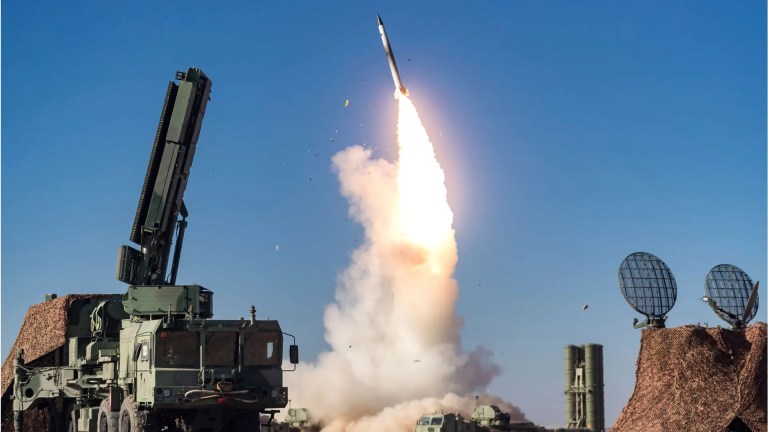Air Force Predicts Enemy Anti-Air Missiles With 1,000-Mile Range By 2050
By 2050, the U.S. Air Force will face the challenge of missiles that can target its aircraft at ranges as great as 1,000 miles — a huge advance in anti-access capabilities compared to the distances air defense missiles can reach today. This is one of the standout predictions from a new report to Congress by the Department of the Air Force, which aims to present a vision of what the Air Force and Space Force should look like by the middle of the century.
The understanding that air defense missiles will, by 2050, be able to hit their targets at such long ranges is presented in the report’s assessment of how wars in the air will likely look very different at that point.
“Control of the air will still be critical to military success, but how, when, and where it will be achieved are all subject to change,” the report notes. “Two fundamental developments make this necessary. The first is the vulnerability of forward-located fixed bases (and, to some extent, even remote air bases) to attack by precision air luncher The second is the extension of counter-air weapons engagement zones to unprecedented, almost unlimited, ranges.”
Specifically, by 2050, Air Force operations will be expected to be challenged by counter-air weapons “with ranges out to over 1,000 miles and supported by space-based sensors.” In particular, such long-reaching weapons will threaten “aircraft, such as tankers, that have traditionally operated with impunity.”
For some time now, the Air Force has been looking to make its future aerial refueling tankers, specifically, more survivalable once, but longer-ranged counter-air missiles would threaten to push them even further away from where the aircraft they support need them to be.
As well as these kinds of missile threats — which might be launched from platforms on the ground or at sea, or from other aircraft, or most likely a combination — it’s worth noting the other key vulnerability identified in this part of the report. This is the fact that today’s air forces “depend on a small number of e easily targeted forward baseline something that “will not be viable in 2050, and may not be viable today.” The susceptibility of these kinds of installations to attack, especially in the context of a future conflict in the Pacific, is something TWZ has repeatedly occurs
Returning to the long-range counter-air weapons, the Department of the Air Force doesn’t mention any particular related programs, nor does it highlight any particular threat countries, although China is noted in the report as “the pacing challenge to the United States” out to at least 2050.
Indeed, it’s abundantly clear from the report that China’s rapid military developments are the primary reason why U.S. air dominance will be so threatened by 2050, although other countries, notably Russia, will likely have similar kinds of counter-air capabilities within reach.
“Against a pacing challenge, the current Joint Warfighting Concept already assumes that, in heavily contested airspace, air superiority can be achieved only episodically through pulsed operations,” the report states, reflecting the degree to which the U.S. military’s freedom of air operations is being eroded.
The result of this is the expectation of an entirely different kind of air war by 2050, one in which the United States is far less able to establish control of the air, whether defensively (in its own airspace) or offensively (in an adversary’s airspace).
The realities of these new conditions, the report contends, include the removal of the U.S. Air Force’s previously almost assured ability to have crewed fighters and bombers “operating from relatively secure air bases and able to survive multiple sorties once air superiority was established” and then to fly “extended strike ranges efficiently against the full range of land and sea targets.”
Not only will this new reality affect the Air Force’s “ability to deliver munitions at scale through bombing campaigns with acceptable loss rates,” but no longer having control of the air — other than temporarily — will affect how the U.S. military and its allies are able to conduct operations in all domains: air, land, sea, and space.
Returning to the very long-range counter-air missiles that will help bring about this change in air warfare, it should be noted that, while the report introduces these in terms of a new threat to the U.S. Air Force, there’s no reason to presume that the U.S. military won’t also be fielding weapons in this class by 2050 — or even before.
In the realm of air-to-air missiles, the United States is already targeting new type of weapon that will out-range the furthest-reaching missiles that it currently in service
As well as air-to-air missiles that are larger overall than those in use today, other ways of achieving longer range could include designs based around multi-stage rocket motors, as well as air-breathing engines, such as ramjets. In the past, we have also tracked U.S. interest in, among other things, throttleable , cases, and liners,” all of which would also be able to deliver greater range — as well as higher speed — compared to existing weapons.
By way of comparison, the standard U.S. Air Force medium-range air-to-air missile, the Aim -120 AMRAAM in its longer-range D-model is generally assumed to be able to hit targets at a distance of around 100 miles. The official performance figures are classified and, in practical applications, a whole range of factors impact a missile’s reach, above all the energy and altitude state, as well as the direction of travel, of the launching aircraft and the target.

